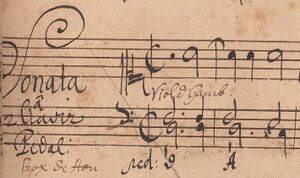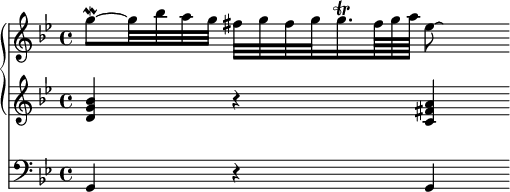Pipe-organ.wiki:Incipits style guide

Incipits are one of the primary features of pipe-organ.wiki. The thematic index of works by organ composers (as opposed to a list of titles) can be a valuable reference to organists. Please note the following style guide so that incipits can be a useful as possible without taking up too much space.
Caution
This article is written by William and other future administrators of pipe-organ.wiki and is protected. It does not adhere to the reference-based style of the rest of the wiki and instead contains our original thoughts pertaining to how incipits should be styled.
See also
Introduction
Incipits are entered using the Score extension which uses Lilypond (or ABC) notation. Do not upload scans of a score and embed the image in place of an incipit, or upload an incipit created with some other music notation and exported in PDF or image format. For a brief introduction to the Lilypond notation method, see [1] and then [2][1].
One nice feature of Lilypond that separates it from other text-based notation software such as musixtex is the input syntax as a lot of flexibility in terms of how much control the user has over the output, so you can be as strict or as lenient as you like. Feel free to follow this in writing incipits for pipe-organ.wiki.
Write the incipit in the following way (the musical notation should be written as it would appear after \score [text]):
<score>\relative c' { r16 c d e f d e c g'8 }</score>

The resulting image is placed in-line where you write it. So you can include an incipit in a table.
{| class="wikitable"
|-
| [[Nicolaus Bruhns]] || Prelude in E Minor || <score>\relative e { \clef bass e16 g e g fis a fis a g b g b a c a c }</score>
|}
| Nicolaus Bruhns | Prelude in E Minor |
Guidelines
The following is a general style-guide for how to enter incipits.
What part
The incipit should only be of the very start of the piece, even if a certain thematic material enters later. For example, the incipit for An Wässerflussen Babylon by Johann Sebastian Bach should be something like

not

Multiple movements
Sometimes it is appropriate to mark incipits for multiple sections of a piece. Hopefully wether or not to do this for a piece will be self-evident, but a general rule of thumb are titled sections ("Prelude" and "Fugue", not tempo markings for different sections[2]), sections clearly marked in the score (such as "Mort et Resurrectio" by Jean Langlais in which the first 15 or so pages are "1. Mort" and the last three are "2. Resurrectio"), or large-scale movements of a piece (like an organ symphony).
Some examples
- Organ symphony, Suite, etc. - Beginning of each movement
- Prelude and Fugue - Prelude, Fugue
- Preludium (by Dietrich Buxtehude, etc.) - ONLY ONE incipit
- Chaccone, Passacaglia, etc. - One incipit
Length
The length of the incipit does not have to be long. It should only be long enough to identify which piece it is or to differentiate it from another of the same name.
For example,

is much longer than necessary to identify what piece this is. A shorter incipit like the following is sufficient.

Even if it is a bit short, the combination of this with the composer and name of the piece should eliminate all doubt.
One caveat is that sometimes several pieces start very similarly to each other. One example of this is the Preludes WV 32 and 35 by Heinrich Scheidemann. In these cases, a temporary solution can be used, such as putting a later section of the piece separated by double bars.
In general, you should try to make the incipit approximately the same length as others in the table if you are adding to a list of incipits. Don't make one that is much longer than the others, and at the same time you don't have to make it much shorter than the others. See one of the admin's incipits lists such as Paul Siefert for an example of how the incipits should be around the same length. If you like, you can try to make all the incipits shorter by a note or too (as long as they will not be too short!).
Staves
New in 2024: Using multiple staves for incipits IS OK. If you would like to include all voices in an incipit and it is not possible to do this with one staff (there would be too many ledger lines), you can use multiple staves. Make sure to use your best judgement as to if this is the best decision.
For example,

is acceptable, but the following is also possible.

Clefs
Feel free to use any clefs, including those which are not original to the score.
Other Notes
On Perfection
The incipit may not always look 100% perfect, but don't worry, it will be good enough! For example, in this incipit for the final variation of the Choral varie on Veni Creator by Maurice Duruflé, the "3" for the tuplet is not in the right place.

For some, this will be an absolutely unacceptable conclusion. For those who think like this, feel free to tinker with the score snippet as much as you like to get the output you desire. For everyone else, don't stress this part too much, we appreciate you entering the incipits in the first place!
Notes
- ↑ Mirrored at partitura.org.
- ↑ Unless of course these are movements of a Sonata for example.